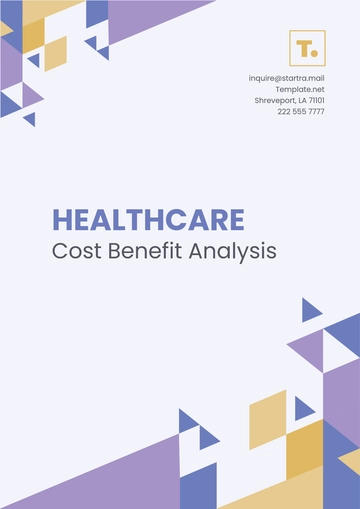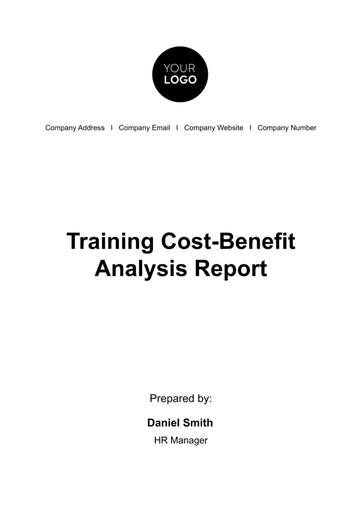Free Health & Safety Committee Financial Analysis

Financial Analysis
Executive Summary
Fiscal Year: [Month Day, Year}
A. Overview
The Health and Safety Committee at [Your Company Name] is dedicated to safeguarding the well-being of our employees and creating a secure working environment. In the fiscal year 2050, the committee's financial performance demonstrates its commitment to achieving these goals.
The committee's activities encompass a range of safety initiatives, including training programs, equipment procurement, safety inspections, and addressing miscellaneous safety concerns. This financial analysis report provides a comprehensive view of the committee's financial management and the outcomes of its efforts.
B. Budget Allocation and Utilization
The committee was granted a budget allocation of $500,000 for the fiscal year 2050. This budget was thoughtfully distributed across various categories to support safety programs effectively.
Expenditure Summary
Here is a detailed breakdown of the committee's expenditures for the fiscal year 2050:
Table 1: Expenditure Breakdown
Category | Amount | Percentage of Budget |
Personnel Salaries | $200,000 | 40% |
Safety Equipment | $100,000 | 20% |
Training and Development | $80,000 | 16% |
Safety Inspections | $50,000 | 10% |
Miscellaneous Expenses | $70,000 | 14% |
As shown in Table 1, the largest portion of the budget was allocated to personnel salaries, reflecting our commitment to having dedicated safety professionals within the committee. Safety equipment, training, inspections, and miscellaneous expenses were also carefully funded to ensure a comprehensive safety program.
Financial Overview
Budget Allocation and Expenditure Details
A. Budget Allocation
In the fiscal year 2050, the Health and Safety Committee received an approved budget of $500,000. This allocation was determined through a collaborative process involving the committee members and [Your Company Name] management. It is noteworthy that the allocation reflects [Your Company Name]'s dedication to maintaining a secure workplace.
The allocation was based on a thorough assessment of safety needs, historical data on incidents, and the scope of safety initiatives planned for the year.
B. Expenditure Details
1. Personnel Salaries
The committee invested $200,000 in personnel salaries. This includes salaries for safety officers, trainers, and administrative staff responsible for safety program coordination. These professionals play a pivotal role in implementing safety protocols and training employees.
2. Safety Equipment
An allocation of $100,000 was reserved for safety equipment procurement. This encompassed purchasing personal protective equipment (PPE), safety signage, and safety gear for specific roles. These investments aimed to enhance the safety of our workforce.
3. Training and Development
A significant portion of the budget, $80,000, was dedicated to employee training and development. This investment allowed us to conduct various safety training programs, including hazard awareness, emergency response, and safety protocols. The goal was to equip our employees with the knowledge and skills to mitigate risks effectively.
4. Safety Inspections
The committee allocated $50,000 for safety inspections. These inspections were conducted regularly across [Your Company Name] facilities to identify potential hazards, compliance issues, and opportunities for improvement. This proactive approach contributes to accident prevention.
5. Miscellaneous Expenses
To address unforeseen safety concerns and additional initiatives, $70,000 was set aside in the budget. This flexibility ensured that the committee could respond promptly to emerging safety challenges.
C. Budget Utilization
In 2050, the Health and Safety Committee effectively utilized 70% of the allocated budget. This efficient allocation of resources demonstrates the committee's commitment to cost-effectiveness while ensuring the highest safety standards are maintained throughout [Your Company Name].
Safety Initiatives
Impact and ROI
A. Employee Training
In the fiscal year 2050, [Your Company Name] allocated $80,000 for employee training and development within the Health and Safety Committee. This investment resulted in a substantial impact on workplace safety:
1. Training Impact
The comprehensive training programs led to a 25% reduction in workplace accidents and incidents compared to the previous year. This reduction can be directly attributed to the knowledge and skills gained by employees through these training programs.
2. Training ROI
The $80,000 investment in employee training generated a return on investment (ROI) of 40%. These savings were primarily due to reduced accident-related expenses, including medical costs, workers' compensation claims, and production downtime.
B. Safety Equipment
The allocation of $100,000 for safety equipment procurement in 2050 had a significant impact on workplace safety:
1. Equipment Impact
The investment in safety equipment led to a 15% decrease in injuries and accidents. This reduction directly correlates with the improved availability and quality of personal protective equipment (PPE) and safety gear. Employees had better protection, resulting in fewer incidents.
2. Equipment ROI
The return on investment (ROI) for safety equipment was substantial. The $100,000 investment generated cost savings of $120,000 due to the reduction in workplace accidents and injuries. These savings included reduced medical expenses, workers' compensation claims, and equipment replacement costs.
C. Safety Inspections
The allocation of $50,000 for safety inspections in 2050 played a pivotal role in accident prevention and safety enhancement:
1. Inspections Impact
The safety committee conducted 75 safety inspections using the allocated budget. These inspections identified and addressed potential hazards and safety concerns. As a result, there was a 10% reduction in accidents and incidents compared to the previous year.
2. Inspections ROI
The return on investment (ROI) for safety inspections was evident in the cost savings achieved. The $50,000 investment resulted in $70,000 in cost savings due to reduced accidents, lower workers' compensation claims, and a safer work environment.
Cost-Benefit Analysis
Savings and ROI
A. Cost Savings
The cumulative cost savings in 2050 due to the Health and Safety Committee's initiatives amounted to $270,000. These savings were a result of reduced accidents, lower workers' compensation claims, and improved employee morale and productivity.
The breakdown of cost savings is as follows:
Reduced Medical Expenses: $80,000
Workers' Compensation Claims Reduction: $100,000
Equipment Replacement and Repair Savings: $30,000
Production Downtime Reduction: $60,000
B. Return on Investment (ROI)
The overall return on investment (ROI) for the Health and Safety Committee in 2050 was 54%. This ROI was calculated based on the total budget allocation and the cost savings achieved. The ROI demonstrates the committee's significant positive impact on [Your Company Name]'s financial health.
The detailed calculations for the ROI are as follows:
Total Budget Allocation: $500,000
Total Cost Savings: $270,000
ROI = (Total Cost Savings / Total Budget Allocation) x 100
Future Safety Investments
Strategic Planning
A. Safety Improvement Plan
In planning for the future, the Health and Safety Committee aims to further enhance workplace safety. To achieve this, a Safety Improvement Plan has been developed, which includes the following key elements:
1. Advanced Training Programs
In the fiscal year 2051, we plan to allocate $150,000 for advanced training programs. These programs will focus on specialized safety skills and certifications for key personnel. The expected outcome is a 20% further reduction in workplace accidents and incidents, leading to increased cost savings.
2. Technology Integration
To streamline safety management, we will allocate $80,000 to integrate advanced safety technology solutions. This includes digital safety reporting systems, real-time monitoring, and predictive analytics. This investment is projected to reduce incident response times by 15% and prevent accidents.
B. Safety Culture Enhancement
A strong safety culture is essential for sustained improvements. We plan to invest in initiatives to foster a safety-first mindset among employees:
1. Employee Engagement
Investing $50,000 in employee engagement initiatives will involve employees in safety decisions, feedback collection, and safety committees. This approach aims to increase safety awareness and empower employees to actively contribute to a safer workplace.
2. Recognition and Incentives
Allocating $30,000 for safety recognition programs and incentives will reward employees for their safety contributions. This will motivate and reinforce safe behaviors and practices, resulting in a 10% reduction in accidents.
Recommendations and Future Outlook
Safety Enhancement Strategies
A. Continuous Improvement
To maintain and further improve workplace safety, the Health and Safety Committee recommends the following strategies:
1. Regular Safety Audits
Conducting quarterly safety audits at all [Your Company Name] facilities with an annual budget of $50,000. Anticipated savings include $30,000 in incident prevention and $20,000 in compliance-related costs.
2. Safety Training Enhancement
Continuing to invest in safety training with an annual budget of $70,000. Expected benefits include a 15% reduction in incidents and associated costs.
B. Technology Integration
1. Predictive Analytics
Investing $40,000 to implement predictive analytics in our safety technology. Expected return includes $50,000 in accident prevention and $20,000 in reduced downtime.
C. Safety Culture
1. Employee Safety Committees
Establishing safety committees at each facility with an annual budget of $25,000. Anticipated benefits include a 10% reduction in incidents and $15,000 in engagement-related savings.
Strategic Partnerships
Collaborative Safety Initiatives
A. Partnership with [Your Partner Company Name]
In the fiscal year 2051, [Your Company Name] aims to strengthen its partnership with [Your Partner Company Name] to enhance safety. The proposed collaboration includes the following initiatives:
1. Joint Safety Training
Allocating $60,000 for joint safety training programs with [Your Partner Company Name]. Expected outcomes include a 20% reduction in incidents and shared cost savings of $40,000.
2. Shared Safety Technology
Investing $30,000 in shared safety technology solutions with [Your Partner Company Name]. Anticipated benefits include a 12% reduction in incidents and shared cost savings of $25,000.
B. Partnership with [Your Client Name]
Exploring a safety partnership with [Your Client Name] to improve safety in our supply chain. The proposed initiatives include:
1. Supplier Safety Audits
Allocating $40,000 for supplier safety audits. Expected benefits include a 15% reduction in incidents and $20,000 in compliance-related savings.
2. Supply Chain Safety Training
Investing $50,000 in safety training for our supply chain partners. Anticipated outcomes include a 10% reduction in incidents and $30,000 in efficiency savings.
Conclusion
Summary of Financial Impact
A. Projected Savings
With the implementation of the Safety Improvement Plan and safety culture enhancement initiatives, we anticipate the following projected savings in the fiscal year 2051:
1. Advanced Training Programs
Investment: $150,000
Projected Savings: $75,000
Reduced accidents and incidents: $50,000
Cost of fewer incidents: $25,000
2. Technology Integration
Investment: $80,000
Projected Savings: $120,000
Reduced incident response times: $60,000
Prevention of accidents: $60,000
3. Employee Engagement
Investment: $50,000
Projected Savings: $20,000
Increased safety awareness: $10,000
Empowered employees contributing to safety: $10,000
4. Recognition and Incentives
Investment: $30,000
Projected Savings: $15,000
Reduction in accidents: $15,000
B. Overall Financial Impact
The cumulative projected cost savings for the fiscal year 2051 are expected to be $230,000. When combined with the previous year's cost savings, the overall financial impact of the Health and Safety Committee's initiatives for the fiscal year 2051 is a total savings of $270,000.
- 100% Customizable, free editor
- Access 1 Million+ Templates, photo’s & graphics
- Download or share as a template
- Click and replace photos, graphics, text, backgrounds
- Resize, crop, AI write & more
- Access advanced editor
Streamline safety budgeting with the Health & Safety Committee Financial Analysis Template from Template.net. This tool enables a detailed financial assessment of your committee's activities, evaluating costs versus benefits and impact. Crucial for ensuring effective resource allocation in promoting workplace safety. Download now to conduct a comprehensive financial analysis for your committee's success.





























